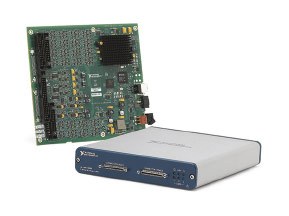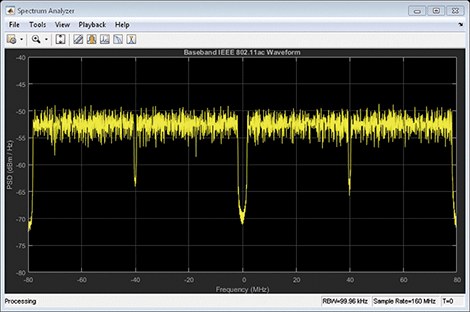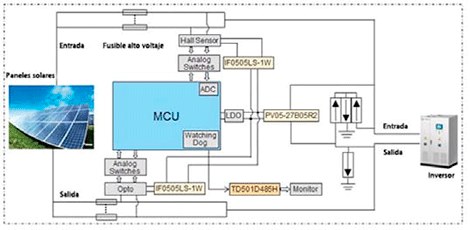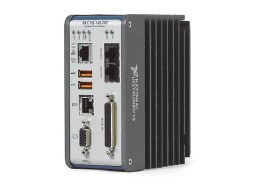“Thanks to National Instruments technology and the extensive knowledge that our engineers have of it, it has been possible to develop this test system saving time in the design and testing stages in terms of hardware design and system communication, providing our engineers more time for the design and improvement of the prototypes necessary to connect with the product”
The challenge
Construction of a test bank that allows the verification and validation of high-speed digital communications, generated and received by the main modules that make up the digital communication system of the MTG (Meteosat Third Generation) Satellites.
The solution
Use a high-performance PXI system together with modules that allow a high communication bandwidth between them, and a data acquisition and generation system, equipped with Streaming capacity. Development of a program in LabVIEW to manage the test bench.
The EIIT Special Test Equipments department, with more than 25 years of experience developing test systems for electronic products, and R&D projects, has proposed the design and manufacture of a test bench that carries out the validation of the high-speed digital communication systems that will be shipped on the MTG Satellites, and therefore require exceptionally demanding design and quality control.
The main objective of the test benches will therefore be to establish a suitable environment for the HIL (Hardware In the Loop) tests of these systems.
Due to the confidentiality of the project, no mention will be made of specific elements of the system or its functionality, but it is intended to explain the problem and the solution from general points of view, so that any reader can get an idea of the casuistry, operation and invested efforts.
The products that are intended to be tested and validated are part of a high-speed digital communications system and must be subjected to data transfers of several Giga Bytes (1GB/3s), being able to store files of hundreds of GB.
Taking into account that the system must certify a transfer rate of 192MB/s•channel, both the transmission and the storage speed at these speeds are a challenge considering that a PCI bus directly connected to a motherboard of any computer presents a maximum transfer rate of 133MB/s.
Due to the high communication speeds, the test bench must be able to manage a large amount of information, performing on-line processing tasks, as well as continuous file access operations for writing/reading the data, all of this without slowing down the main generation/acquisition processes.
All this process must be governed by a specific software environment capable of controlling and supervising each of the different processes, as well as presenting the user with all the necessary information on the screen and generating the necessary test reports.
To be able to reach these levels of demand in terms of speed of transmission, reception and handling of data, it has been required the use of an NI-PXI system made up of: NI PXIe – 1071, NI PXIe – 8133 Controller, NI PXIe – 6545, NI PXI – 6509, NI PXI – 8262 + NI HDD – 8264, Design/manufacturing of specific PCBs for high-speed digital signal management and LabVIEW
The NI-PXI1071 is a high-performance chassis that has three PCIe slots capable of supporting a bandwidth of up to 3GB/s. Through the NI PXI - 6545 module we are able to obtain communication rates of 660MB/s in acquisition and 400MB/s for the generation of digital signals thanks to the internal memory of the card and the Streaming capacity of this NI hardware. is gifted.
Using the chassis communication buses we are able to establish communication with the PXI - 8262 that interfaces with the NI HDD - 8264 hard drives. This NI hardware provides us with 12 hard drives with a capacity of 250GB each, with a total storage capacity of 3 TB, and a read and write speed of up to 600MB/s, sustainable up to 2TB.
Along with these two cards, we have provided the system with a PXI – 6509 for handling certain control signals necessary to perform the required tests.
All this communication and control system is finally governed with the NI PXI – 8133 controller, which has a Windows system for the user's comfort and the control software developed in LabVIEW.
Description of the operation of the equipment
The final equipment consists of two different test benches:
The first one, called “Receiver”, is responsible for the reception, processing and subsequent storage of the data and its objective is to validate the functionality of the satellite data generation systems.
The second, called "Transmitter", is responsible for retrieving the information located in the storage systems and sending it to the satellite data reception systems, in order to validate its functionality.
The "Receiver" test bank must be able to connect to 4 different satellite data generation systems, in order to test and validate the functionality of each of them, as well as verify the transfer rates and possible errors that may occur during communication. Therefore, the test bank will consist mainly of 4 data inputs that will be multiplexed to a single acquisition system. The case of the "Transmitter" is similar, but in this case the bank will be made up of a single generation system whose information will be multiplexed to four data outputs that will be coupled to 4 different satellite data acquisition systems.
The coupling of both test benches with the corresponding satellite systems will be carried out by means of special cables whose lengths will vary between 4 and 8m. Due to these lengths and high speeds, the PCB has been designed to avoid distortion, noise and interference in the transmitted signals, as well as to avoid jitter problems in the clock signals, which are in the order of a few picoseconds.
Communication with the test system can be done locally, or as required by the client, which is accessible through the TCP/IP protocol.
Conclusion
Thanks to National Instruments technology and the extensive knowledge that our engineers have of it, it has been possible to develop this test system saving time in the design and testing stages in terms of hardware design and system communication, providing our engineers more time for the design and improvement of the prototypes necessary to connect with the product.
The perfect integration of the cards with the software development environment, as well as the design of the system control through digital signals towards the equipment elements that only require static control signals, has significantly reduced software development time, anticipating the schedule established by our client.







